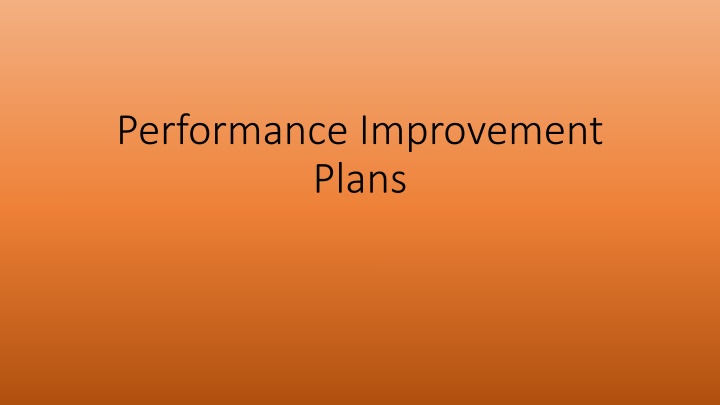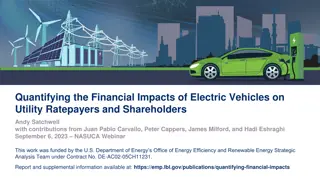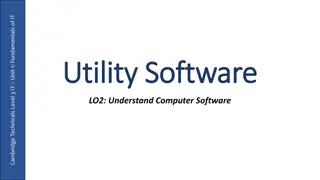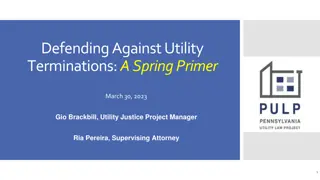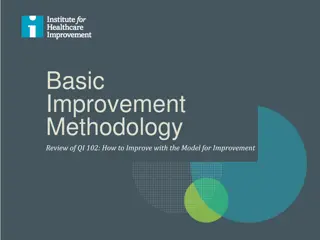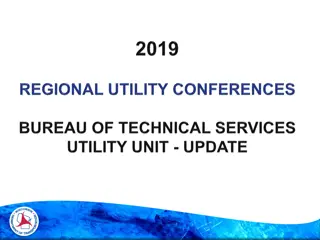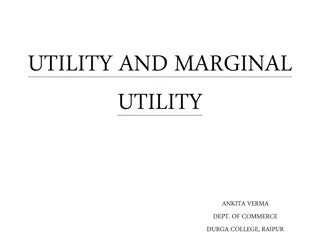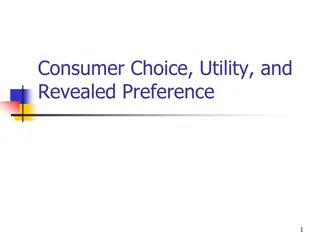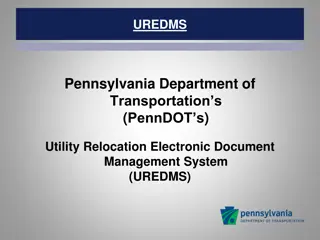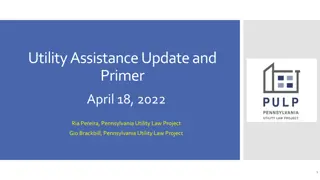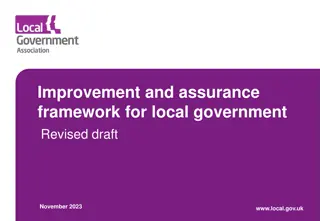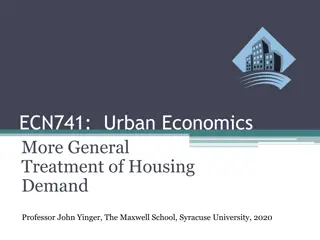Utility Performance Improvement Strategies
Effective utility performance improvement involves benchmarking, selecting key performance indicators (KPIs) aligned with strategy, developing improvement plans, and implementing initiatives to achieve targets. This process entails identifying focus areas, setting improvement targets, and implementing strategic initiatives to enhance performance across different areas such as renewable energy, operational costs, and financial efficiency. The emphasis is on continuous data collection, risk assessment, and prioritization to drive sustainable improvements in utility operations.
Download Presentation

Please find below an Image/Link to download the presentation.
The content on the website is provided AS IS for your information and personal use only. It may not be sold, licensed, or shared on other websites without obtaining consent from the author.If you encounter any issues during the download, it is possible that the publisher has removed the file from their server.
You are allowed to download the files provided on this website for personal or commercial use, subject to the condition that they are used lawfully. All files are the property of their respective owners.
The content on the website is provided AS IS for your information and personal use only. It may not be sold, licensed, or shared on other websites without obtaining consent from the author.
E N D
Presentation Transcript
Performance Improvement Plans
Value of Benchmarking Ultimately, the value of benchmarking is in utilising the results to develop and implement an action plan that will lift performance. Areas of priority and KPI performance targets will be different for each utility. For example your board area of focus this year could be: Improve percentage of renewable energy Reduce operational costs Lift financial performance
Approach to select KPIs Alignment with utility strategy/focus Least cost option Risk Assessment Improving data collection and reporting Your Benchmarking exercises and data collection will provide utility managers with tools necessary for developing improvement initiatives. Where data collection and storage are seem to be inadequate, setting up data recording system will be a positive first step.
Improvement Planning Template KPIs that relate to the focus areas need to be identified Targets set for improvement and then strategic initiatives developed and implemented to achieve the target set. Priority Improvement Plan Template Priority Improvement Plan Priority KPI Current Benchmarking Target Improvement Initiatives KPI A Eg. Reduce SAIDI 250 Extensive VM, allocate additional men power , etc KPI B KPI C
Examples of Improvement Each utility will need to consider the initiatives that will best address the KPIs they are targeting within their own context.
Improvement Plan Initiatives KPI# Indicator Name Generation Value Unit Improvement Initiative Implement measures to shift demand from peak to off peak e.g. Tariffs, DSM initiatives % 1 Load Factor Review/set spinning reserve policy/operational policy Improve generation reliability to enable less standby capacity % 2 Capacity Factor Preventative maintenance Improve planned outage to reduce forced outages % 3 Availability Factor HR management strategies GWh/FTE gen. emp 4 Generation Labour Productivity Engine Maintenance Review generation dispatch policy kWh/L 5 Specific Fuel Oil Consumption Check quality of oil kWh/L 6 Lub Oil Consumption
Improvement Plan Initiatives KPI# Indicator Name Generation cont Value Unit Improvement Initiative Maintenance Plan Regular Inspections/Test to detect need for maintenance Incentivise Employee Performance, Templates/Recording System Publicise data Review Staffing Requirements Address losses Reduce unbilled usages Employ DSM activities in Power Station Conduct a resource review on renewable energy options Progress with studies already completed 7 Forced Outage % 8 Planned Outage % USD/MWh 9 Generation O&M Costs 10 Power Station Usage % 11 Renewable Energy to Grid %
Improvement Plan Initiatives KPI# Indicator Name Generation cont Value Unit Improvement Initiative Consider IPP agreements 12 IPP Energy Generation % Review fuel mix Consider RE options. 13a Distillate Generation, HFO, Biofuel, etc. Develop enabling environment 14 Enable Framework for Private Sector
Improvement Plan Initiatives KPI# Indicator Name Transmission Value Unit Improvement Initiative Redesign of transmission network Consider installing capacitors 15 Transmission Losses % Preventative maintenance 16 Transmission Reliability Outage events/km Preventative maintenance h 17 Average Transmission Outage Duration
Improvement Plan Initiatives (Distribution) KPI# Indicator Name Value Unit Improvement Indicator Phase Balancing Proper Design and Planning Determine proportion of technical & non- technical losses Address issues of theft, faulty meters, lack of metering Human Resources Management Plan Increase customer connection 18 Network Delivery Losses % 19 Distribution Losses % 20 Customers per Distribution Employees Cust/distributi on employee 21 Distribution Reliability Events/100 km Preventive maintenance 22 Distribution Transformer Utilisation % Ensure adequate planning for distribution expansion Correct sizing if new transformers Review staffing requirements Address losses Reduce unbilled usage# Consider automation Fault locators 23 Distribution O&M Cost USD/km
Improvement Plan Initiatives (Distribution) KPI# Indicator name Value Unit Improvement Indicator Preventive Maintenance Review/improve network redundancy Automate switching Improved recording of outage data Preventive Maintenance Review/improve network redundancy Automate switching Improved recording of outage data 24 SAIDI % 25 SAIFI %
Demand Side Management KPI# Indicator Name Value Unit Improvement Initiative 26 DSM Initiatives Set DSM Budget Link Budget to expected outcomes Reward employees for successful implementation/performance based remuneration/bonuses 27 DSM Budget USD 28 DSM FTE Employees # 29 DSM MWh Savings MWh 30 Power Quality Standards
Human Resources / Safety KPI# Indicator Name Value Unit Improvement Initiative 31 Lost Time Injury Duration days HR management plan Safety Initiatives Use Safety Standards PPE Training and awareness 32 Lost Time Injury Frequency Rate Performance Based Remuneration 33 Labour Productivity %
Customers / General KPI# Indicator Name Value Unit Improvement Initiative 34 Service Coverage % 35 Productive Electricity Usage % 36a Lifeline Tariff Usage , Domestic Usage, Industrial, etc Install/repair meters Prepaid meters Implement DSM activities for legitimate unbilled customers 37 Customer Unbilled Electricity % 38 Self Regulated or Externally Regulated
Financial Indicators KPI# Indicator Name Value Unit Improvement Initiatives 39 Operating Ratio Reduce costs Increase revenue 40 Debt to Equity Ratio % 41 Rate of Return on Assets % Increase profit 42 Return on Equity % Increase profit 43 Current Ratio % Maintain sufficient current assets to cover liabilities 44 Debtors Days Days Incentivise payment by Due date Ensure access to pay bill is easy Pre-paid meters 45 Average Supply Cost US cen/kWh Cost management Improve utilisation of assests
Improvement plan Once a Priority Improvement Plan has been formed, it is then resourced, planned and implemented Regular review of KPIs is helpful (monthly or quarterly review) to pre- empt adjustments Improve data collection (data reliability)
Data Component Reliability Assessment Questions Question Description Reliability Grade(A,B,C or D) i How is fuel consumption calculated or derived? ii How are generation quantities calculated or derived? iii How are customer outage impacts calculated or derived? iv How are network demands and capacity utilisation calculated or derived? v How are the number of connections or customers calculated? vi Where is financial information sourced from?
Reliability Evaluation Reliability Grade Reliability Description A Highly Reliable Data is based on sound records, procedures, investigations or analyses that are properly documented and recognised as the best available assessment methods. Effective metering or measurement systems exist B Reliable Generally as in Category A, but with minor shortcomings, e.g. some of the documentation is missing, the assessment is old or some reliance on unconfirmed reports; or there is some extrapolation made (e.g. extrapolations from records that cover more than 50 percent of the utility system). Generally as in Category B, but data is based on extrapolations from records that cover more than 30 per cent (but less than 50 per cent) of the utility system. C Unreliable D High Unreliable Data is based on unconfirmed verbal reports and/or cursory inspections or analysis, including extrapolations from such reports/inspections/analysis. There are no reliable metering or measurement systems.
Reliability Grading Guidance Reliability Grade Description Related Questionnaire Data input i. How is Fuel consumption calculated or derived? A Accurate records are kept of deliveries, inventory and consumption of oil and fuel type by location, station and unit. Fuel consumption measurement equipment is temperature compensated. Monthly fuel consumption measurement is taken for each unit and fuel consumption audits are regularly undertaken and reconciled by unit. Audits are carried out by both internal and external parties. B Records are kept of deliveries, inventory and consumption of oil and fuel type by location and station. Fuel consumption measurement equipment is not temperature compensated. Fuel consumption measurement is taken for power stations and fuel consumption audits are undertaken and reconciled by power stations. Audits are carried out by internal and external parties. 9,10
Reliability Grade Description Related Questionnaire Data Input C Some records are kept of deliveries, inventory and consumption of oil and fuel type by location and station. Fuel consumption measurement are done by dip stick. Fuel consumption audits are only undertaken by an external party annually and reconciled by power stations 9,10 D Some records are kept of deliveries, inventory and consumption of oil and fuel type by location and station. Fuel consumption measurement are done by dip stick. Fuel consumption audits are rarely undertaken or irregular. Heavy reliance on fuel supplier information
Reliability Grading Guidance Reliability Grade Description Related Questionnaire Data input i. How are generation quantities calculated or derived? A Generation quantities are computed on the basis of measurement by station, unit and auxiliary metering at all grid connected generation points, which are calibrated / verified for accuracy regularly. Generation profiles are monitored continuously and there is an established process for reporting capacity factors. There is an established process for derating of generators and reporting of all related volumes 2 to 8 inclusive 11 to 17 inclusive B Generation quantities are computed on the basis of measurement by unit and station metering at all grid connected generation points. Meters may not be calibrated or verified for accuracy. Reliable generation profiles are available. More manual processing and interpretation of records may be required than A.
Reliability Grade Description Related Questionnaire Data Input C Reliable and calibrated metering is not available at all grid connected generation points. Generation profiles are estimated or extrapolated. Derating information is not routinely recorded. 2 to 8 inclusive 11 to 17 inclusive Aggregated generation information is available, with limited information available on unit and station profiles and capacity factors. No reliable calibrated metering systems exist. D
Reliability Grading Guidance Reliability Grade Description Related Questionnaire Data input iii. How are customer outage impacts calculated or derived? A Details of individual HV network or generation outages are available and used to calculate customer impact measures and reliability statistics. Records of trip times, restoration sequences, and affected customer numbers are available from SCADA, generator, substation, operating or other records. Outage records are suitable for causal analysis and performance improvement. An established and auditable process is used for evaluation of outage impacts 11 to 16 inclusive 20,21,24,27,28 B Reliable assessment of HV network and generation outages are available, but may require more manual processing of information from source records than in A. Customer numbers for network segments and affected areas are used to derive reliability statistics but may not be up to date at all times.
Reliability Grade Description Related Questionnaire Data Input C Where outage impacts are assessed, they use estimates of outage durations and affected customer numbers. It is likely that not all outages are captured in reporting statistics. Limited processes exist for fault causal analysis and reporting. 11 to 16 inclusive 20,21,24,27,28 Outage analysis may only be performed for large outages, if at all. Outage details are not recorded consistently or for reporting purposes. It may be difficult to extract information from generator, substation and operating records. There are no established processes related to customer outage analysis D
Reliability Grade Description Related Questionnaire Data input iv. How are network demands and capacity utilisation calculated or derived? A Calibrated metering equipment is installed at all zone and distribution substations and at consumer s premises for all categories of consumers. Demand information is captured throughout the network. Records are up to date and identify installed capacity of lines and transformers. Billing records and databases reveal regular reading of meters. Established processes exist and are used for reporting of capacity utilisation, losses and network demand profiles. Power system analysis software may be in use and routinely undertaken. Detailed loss breakdowns are regularly updated and available. 4,5,23,26,32 B Generally as per A, although processes and systems are not as developed. Limitations of installed metering and substation equipment will require more manual processing of information. Asset records are missing information requiring some extrapolation for assessment purposes. Power system analysis software or studies may be undertaken from time to time
Reliability Grade Description Related Questionnaire Data Input C Metering is not comprehensive enough to allow evaluation of demand and losses easily throughout the network. There may be significant limitations in the records of installed assets. Billing records and aggregate consumption information is incomplete. D Asset records may be well out of date and metering coverage of the network poor. Major assumptions required for evaluation of utilisation at an aggregate level. No meaningful loss breakdown possible. No recent power system analysis completed. 4,5,23,26,32
Reliability Grading Guidance Reliability Grade Description Related Questionnaire Data input v. How are the number of connections or customers calculated? Billing records and databases clearly identify customer specific meters. Billing processes reveal regular reading of meters and meter readings are the basis for charging consumers. Databases of electricity connections and meters are complete. There is a mechanism to identify faulty meters and repair meters. Processes for installation of new connections, installation of meters and generation of bills based on this are interlinked with a robust process. A B Database/ records reveal the list of customers that have meters installed in their electricity connections. Meter data and associated customer databases may be limited and the linkage with the billing system harder to demonstrate 43 to 56 inclusive
Reliability Grade Description Related Questionnaire Data Input Records do not reveal the exact number of connections which are metered . Not all billing is based on metered quantities. Processes associated with new connections and metering management may not be robust. C 43 to 56 inclusive D No formalised processes for metering and connection management. Number of current connections estimated with poor linkages to billing system and database coverage
Reliability Grading Guidance Reliability Grade Description Related Questionnaire Data input vi. Where is financial information sourced from? A Major budget and functional reporting categories identified and separated. Cost allocation standards for common costs are in place. An accrual based double entry accounting system is practiced. Accounting standards are comparable to commercial accounting standards with clear guidelines for recognition of income and expenditure. Accounting and budgeting manuals are in place and are adhered to. Financial statements have full disclosure and are audited regularly and on time. 59to 83 inclusive B Key costs related to generation and distribution are identifiable, although complete segregation is not practiced. Key income and expenditure is recognised based on accrual principles, but accounting standards may not be comparable to commercial accounting standards. Disclosures are complete and are timely and audits undertaken
Reliability Grade Description Related Questionnaire Data Input C Major budget and functional reporting categories are not clearly separated, eg, between electricity power supply costs and costs for other utility functions such as water, sewerage, etc. Limited useful functional reporting and cost allocation principles in place. Audits may have a significant time lag or may be irregular. 59 to 83 inculsive D There is no segregation of major budget and functional categories, eg, no clear distinction between electricity power supply costs and costs for other utlity functions such as water, sewerage, etc. A cash-based accounting system may be practiced. There are no clear systems for reporting unpaid expenditure or revenues that are due. Disclosures and reporting may not be timely
Online Benchmarking Platform Online Benchmarking Platform WB activity under Sustainable Energy Industry Development Project (SEIDP) is to design capacity development plan for increase in data collection, management and knowledge sharing Develop a web based benchmarking platform that will be used by utilities allowing to submit correct data and get easy excess to results. Preparing TOR in consultation with World Bank experts Two primary functions of online benchmarking platform Act as interface for data submission Results visualization
Online Benchmarking Online Benchmarking Platform Platform Project Outcomes: Develop a web interface for continuous data collection and result visualization Develop an online dashboard to customize output for comparison and trending Create a database to compare past and current performance Train utility and PPA staff to be able to take ownership of the platform. Users Download benchmarking report. Login via PPA website PPA Staff Power utility staff Generate Query Y-Axis Web interface Input: Enter benchmarking data. Customize dashboard X-Axis Output: Comparison summary table of KPIs, charts and trends Benchmarking Platform Data validation Database Data analysis Calculate KPIs, generate summary and comparison report
Outcome of Online Benchmarking Platform Outcome of Online Benchmarking Platform Reduce time and cost of preparing power benchmarking report Reduced data validation time Able to customize and view benchmarking results online Data backup and security Benchmarking report made readily available Easy to train and communicate with utility liaison officers (provide error notes during data submission) How far have we gone into development of PPA s Online Benchmarking Platform At the moment we are evaluating RFP.
VRE Integration Study Assessment of the issues that arise when renewable energy installations are connected into the existing power systems Small systems with radial feeders may become hard to manage Once renewables reach a certain capacity level within the power systems, the systems will also become more operationally complex The locations of renewables installations, their geographical relationship to power stations, available capacities of existing lines and/or cables and system configurations are all significant factors
Grid integration and planning studies - locations Grid Integration & planning studies and SCADA/EMS design SCADA/EMS design Tonga Pohnpei Samoa Marshalls Kosrae Tuvalu Yap Chuuk
Continue Benchmarking It is important for Pacific power utilities to continue performance benchmarking in order to capitalise on the potential gains identified from PPA annual survey and sustain further on-going improvements in the coming years Improvements (performance/ efficiency) will help meet increasing customer expectation, owners and regulators for better power utility performance especially in terms of better prices, service, safety and environmental outcomes Recommend utilities to evaluate their overview benchmarking and overtime progress along the line of detail benchmarking.
